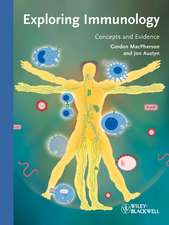Contemporary Topics in Immunobiology: Volume 1
Editat de M. Hannaen Limba Engleză Paperback – 19 mar 2012
Preț: 363.44 lei
Preț vechi: 382.57 lei
-5% Nou
Puncte Express: 545
Preț estimativ în valută:
69.56€ • 71.69$ • 58.73£
69.56€ • 71.69$ • 58.73£
Carte tipărită la comandă
Livrare economică 03-17 martie
Preluare comenzi: 021 569.72.76
Specificații
ISBN-13: 9781468430448
ISBN-10: 1468430440
Pagini: 208
Ilustrații: XIV, 188 p.
Dimensiuni: 152 x 229 x 11 mm
Greutate: 0.29 kg
Ediția:Softcover reprint of the original 1st ed. 1972
Editura: Springer Us
Colecția Springer
Locul publicării:New York, NY, United States
ISBN-10: 1468430440
Pagini: 208
Ilustrații: XIV, 188 p.
Dimensiuni: 152 x 229 x 11 mm
Greutate: 0.29 kg
Ediția:Softcover reprint of the original 1st ed. 1972
Editura: Springer Us
Colecția Springer
Locul publicării:New York, NY, United States
Public țintă
ResearchCuprins
1. Systems of Lymphocytes in Mouse and Man: An Interim Appraisal.- Choice of Working Materials.- In Vitro Systems.- In Vivo Methods.- Primary and Secondary Lymphoid Organs.- Development of the Lymphoid System: Precursor Cell Migrations.- Surface Antigen Changes.- Extrathymic Maturation.- T-Cell Pool and Recirculation.- Organ Distribution of T Cells.- B Cells.- A Working Hypothesis.- Methods of Quantitation of T Cells.- Autoregulation.- Internal Environmental Factors.- External Environmental Factors.- Some Human Implications.- The Congenital Immune Deficiency States.- Lymphoid Neoplasia.- Hodgkin’s Disease.- References.- 2. A Developmental Approach to the Biological Basis for Antibody Diversity.- Development of the Bursal Line of Cells in Chickens.- Theoretical Implications of Generation of Antibody Diversity Within the Bursa.- Conclusions.- References.- 3. The Mammalian “Bursa Equivalent”: Does Lymphoid Differentiation Along Plasma Cell Lines Begin in the Gut-Associated Lymphoepithelial Tissues (GALT) of Mammals?.- Predictions in the GALT Theory.- Conclusions.- References.- 4. C3-Receptor Sites on Leukocytes: Possible Role in Opsonization and in the Immune Response.- Receptors for Immunoglobulin and Complement on Mouse Leukocytes.- Do Lymphocytes Specifically Recognize Antigen-Antibody Interactions?.- Presence of a Receptor for C3 on the Membrane of Certain Lymphocytes (CRL).- Enhancing Effect of Antibody Studied at the Antigenic Determinant Level.- Concluding Remarks.- Acknowledgment.- References.- 5. Surface Immunoglobulins on Lymphoid Cells.- Expression of V Gene in B Lymphocytes.- Expression of V Gene in T Lymphocytes.- Blocking of ABC by Anti-Immunoglobulin Sera.- Blocking of Functional Activities of T Lymphocytes.- Blocking of Functional Activities of BLymphocytes.- Direct Binding of Anti-Immunoglobulins to B Lymphocytes.- Direct Binding of Anti-Immunoglobulins to T Lymphocytes.- Synthesis of Immunoglobulins by B and T Cells.- Immunoglobulin Gene Expression in Lymphoid Cell Differentiation.- Acknowledgments.- References.- 6. Cellular Basis of Immunological Unresponsiveness.- Induction of Unresponsiveness with Heterologous Serum Proteins.- Kinetics of Induction of Immunological Unresponsiveness.- Relationship Between Antibody Formation and the Induction Process of Unresponsiveness.- Adult Mice Rendered Unresponsive to HGG.- Newborn Rabbits Rendered Unresponsive to BSA.- Adult Rabbits Rendered Unresponsive to BSA.- Cellular Sites of Immunological Unresponsiveness.- Termination of Immunological Unresponsiveness.- References.- 7. Application of Marrow Grafts in Human Disease: Its Problems and Potential.- Failure of the Pluripotential Cell (P Cell).- Failure of the Immune System (L Cell).- Failure of the Hematopoietic System (H Cell).- Marrow Transplantation as a Prelude to Organ Grafting.- Marrow Transplantation in the Treatment of Malignancy.- Use of Syngeneic Marrow Where Tumor-Specific Antigens Are Weak or in Doubt.- Use of Syngeneic Marrow Where Strong Tumor Antigens Exist or Are Suspected.- Use of Allogeneic Marrow with Histoincompatible Donors.- Use of Allogeneic Marrow with Histocompatible Grafts.- Preparation of Recipients for Marrow Grafting.- Problems Related to the Presensitized State.- GVH Disease.- Conclusions.- References.









